So, You Think You Love Horses?
Some Reflections on the Nature of Horses and Man
More Discussions by “The Accidental Horseman”
The Gettysburg Battlefield on Horseback
UPDATE 2023 The National Park Service had closed the equestrian trails on the southern and eastern side of the park because of heavy rain, muddy trails and erosion. I understood that there were plans to recreate a rideable circuit. As it happens we have not been back to Gettysburg for some time and I am uncertain of the current status.
Official NPS Map of Gettysburg Trails
The Bridle Path is in Purple, Orange and Yellow Lines
It is basically one big loop with two branch trails to McMillan Woods and Artillery Ridge.
The situation as changed and this map is obsolete. (see below)
The trail no longer is a big loop but is closed at the Big Round Top.
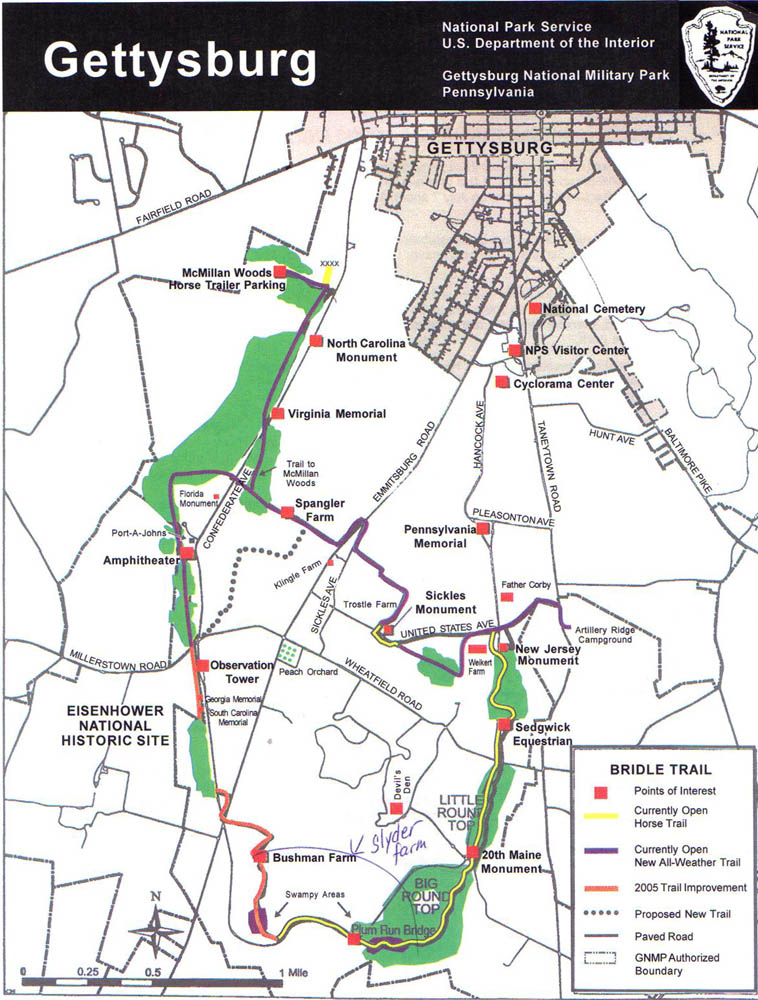
|
Since we live nearby we have taken many trips to the Gettysburg Battlefield, and I am very familiar with the trails and the history of the battle. In prior times Army officers studied the battle on mounted "Staff Rides" and thus there is a long tradition of horseback riding tours of the battlefield. The Army still conducts “Staff Rides” at Gettysburg, but the officers are now riding in motor vehicles. It is a privilege to ride horses on public land, and riders need respect the park’s rules and ride only on designated bridle trails in the park.
A Group of Riders from Tennessee dressed in Period Costume.

|
While horseback riding at Gettysburg I have run into other riders from all over the United States and if you are a person who does long distance traveling with your horse, Gettysburg is no problem. The National Riding Stables at the Artillery Ridge Camping Resort is a private business adjoining the park that can accommodate large horse trailers and has overnight facilities for equine travelers. In is also possible to do day parking for a modest fee or even for free if you are a member of the Gettysburg Equestrian Historical Society. They also do horseback tours for those who do not own their own horses. We find it easier to park there rather than the public horse trailer parking area at McMillan Woods which is off of Confederate Avenue. The entrance road to the McMillan Woods is narrow, and the area devoted to trailer parking is somewhat limited.
McMillan Wood's Parking Area
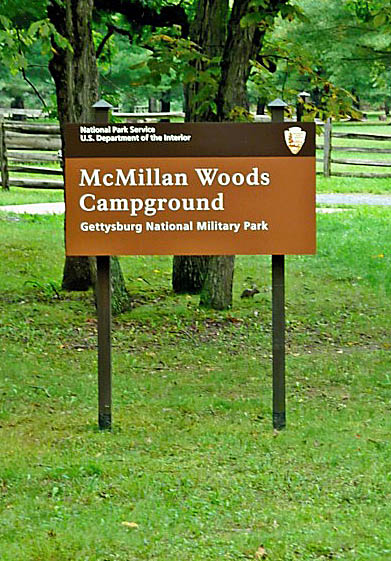
|
|
The trails are very scenic.

|
|
Hickory Hollow Group Tour leaving the Parking Area

| |
So, join us for a little ride on the trails. Our trip begins at the Artillery Ridge Campground located on Taneytown Road. We cross Taneytown Road and ride out to where the trail crosses Sedgwick Avenue. At this point you begin to see the ubiquitous cannons and monuments so typical of Civil War Battlefield Parks. Over your right shoulder in the distance is the large and impressive domed Pennsylvania Memorial and in the distance to your left are the wooded promontories of Big and Little Round Top. Particularly on weekdays the vehicular traffic in the park is light and slow moving and no problem for the rider. The speed limit on park roads is 5 miles an hour. This spot is pretty much in the center of what was the Union line of battle during the second and third days, the famous “Fish Hook” Federal line on the crest of Cemetery Hill that you learned about in school. The next leg of the ride takes you along a picturesque trail lined by traditional "hog tight and cow high" snake-type, split rail fences that were at one time so common on the American rural landscape. One of our horses had never seen anything like these fences and shall we say, found them "intriguing"?
See the Cannons and Monuments

|
|
The Snake Fence

|
|
It looks "intriguing."
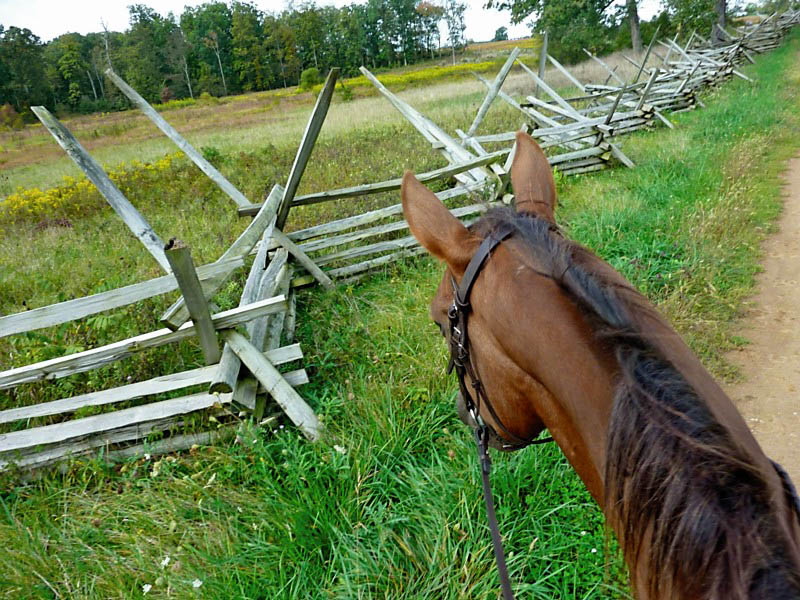
| |
Soon you come to the Trostle Farm. In July of 1863 a number of Pennsylvania farmers approached Union officers with the naïve request that they would please fight their battle somewhere else. Among the farmers whose land was situated in the middle of a battlefield was Abraham Trostle. He and his family fled and returned after the battle to find their place in a shambles. The farmhouse was chosen by Major General Daniel Sickles as the site of his headquarters. Sickles was a colorful figure in American history. He had shot his wife’s lover dead in the streets of Washington, D.C. and was the first American to ever get off with a temporary insanity plea. At Gettysburg he decided, against orders, to move his Army Corps to a position forward of the rest of the Union line and right in the path of the advancing Confederate Army. His men were thrown back with great casualties and Sickles himself lost a leg. However, the Confederate attack was blunted as a result, and the main Union line held. General Meade, the overall Union commander, was furious and hoped to court martial Sickles. Sickles, a politician by profession, may not have understood how to follow orders like a good soldier, but he did understand how to mount an effective public relations offensive. He painted himself as the wounded hero, and Meade soon found that he could not touch him. Years later after the veterans of Sickles command collected funds to build a memorial, it would be discovered that Sickles had embezzled the money. I suspect that old Dan Sickles could have taught a few things to some contemporary American politicians.
The Bridge leading to the Trostle Farm

|
|
A Marker at the Spot General Sickles was Shot
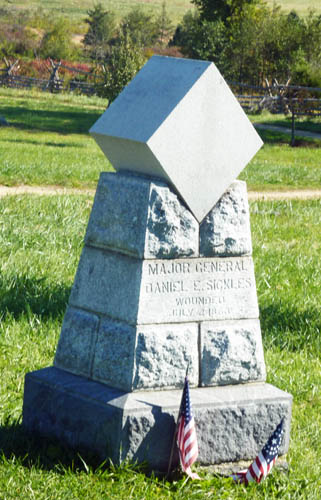
|
|
General Daniel Sickles
An Officer and a Politician
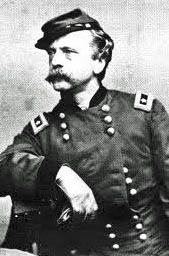
| |
The Trostle Farm after the Battle
We can only imagine how the family felt.
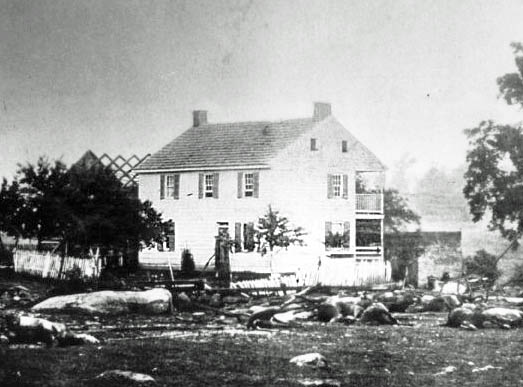
|
|
The Trostle Farm Today
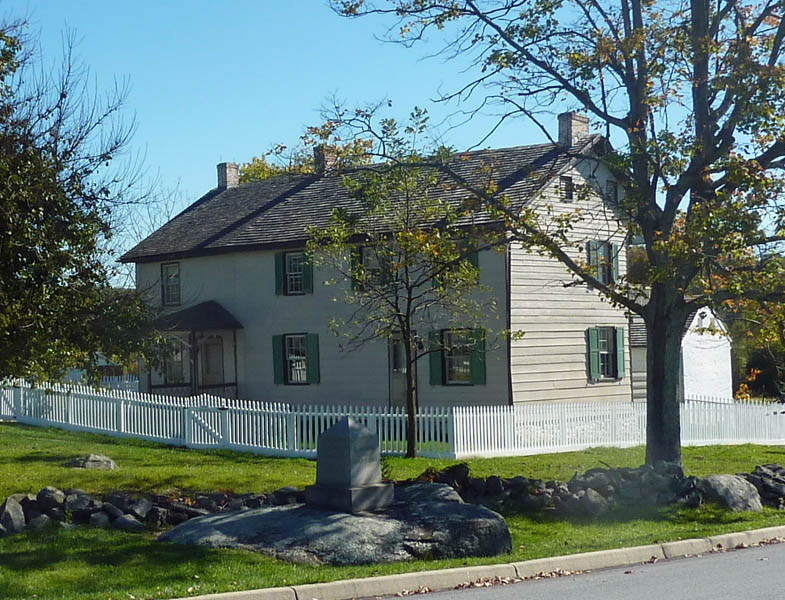
| |
After you pass the Trostle Farm you have a view across the battlefield. If you look to your right towards the town of Gettysburg you see where the Union line was and the point of attack of the famous and disastrous Pickett’s charge by the Confederate Army. Next you cross Emmitsburg Road where there is some fast vehicular traffic to watch for. This is not common on park roads, but Gettysburg is a modern town, its people need to get places and a few roads going through the park have traffic moving at usual speeds. Pickett’s troops also passed over this road but where going in the other direction toward the Union line. At the time of the battle there was a fence along this road that the Southern troops needed to climb over or pull down, which slowed their advance while at the same time their casualties mounted and their numbers dwindled. Looking at the idyllic scene today it is hard to image the horror that awaited the soldiers in 1863, a three day battle that would leave a fourth of them killed, wounded, or captured.
You pass down a lane into the Spangler Farm yard and end up in a wooded area. The trail branches here. The right branch runs parallel to Confederate Avenue and passes by the Virginia monument. It was from this area that the Confederates staged Pickett’s charge. This trail ends up making a left into the lane leading into the McMillan Woods Horse Trailer Parking Area which is also a campground used by scouts and other groups. I remember when I first rode at Gettysburg it was possible to continue north on horseback through the grounds of the Lutheran Theological Seminary and Gettysburg College and visit the areas involved in the first day of the battle. With urban congestion and revision of the designated trails this is no longer possible.
View looking south over Emmitsburg Road
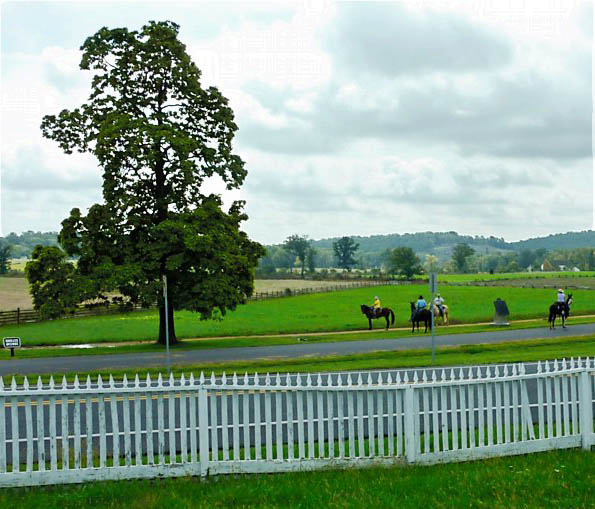
|
|
|
Spangler Farm Lane
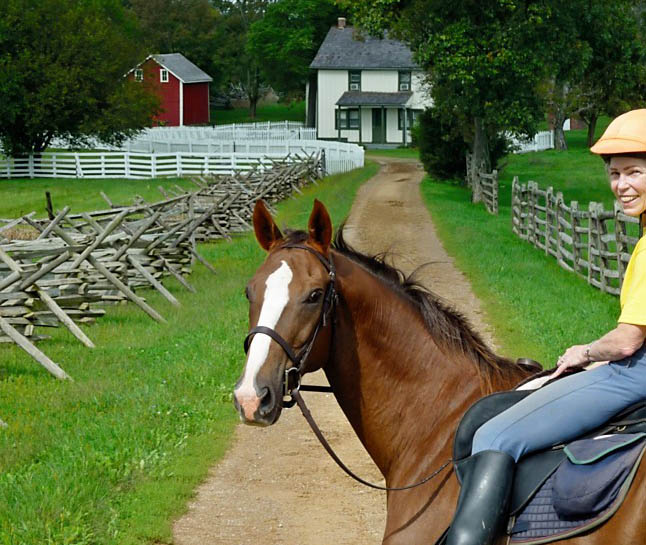
| |
Statue of General Longstreet
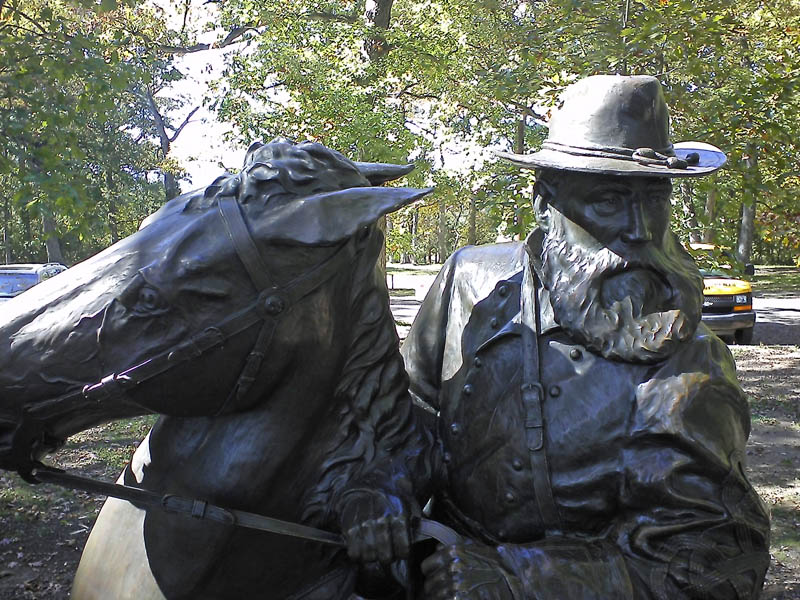
|
|
At this point it was the case when I last rode that you must turn around and retrace your steps. There is a large and beautiful farm located down the hill off to your right, and often its cows will be beside the fence. When you get back to the fork you continue onto the other branch, now to the right, and recross Confederate Avenue. That brings you to an Amphitheater and Port-A-Johns (their official name), a fact you might note just in case you find a sudden and urgent need to include them on your itinerary. Just a short distance up the trail and on the other side of the parking area is a relatively recent equestrian statue of Confederate Lieutenant General James Longstreet that was the work of sculptor Gary Casteel. Longstreet's role at Gettysburg has been a subject of controversy and contributed to the late arrival of his statue on the field. Unlike many other equestrian statues at Gettysburg this one is at ground level and not on a pedestal. While we were passing we decided to have a look and discovered that the horses were spooked by his strange horse that had no scent and was totally still. Might this fate be theirs if they remained at this spot?
Continuing your trip and feeling that sense of relief we all know, you emerge from the woods in an open area with the observation tower to your left and up the hill a bit. It is a regular stop for tour buses and hopefully the loud noise of their air brakes will not inspire your mount into an unintended and unwelcomed canter. If this happens, you will have only the briefest glimpse of the Eisenhower National Historical Site to your right. Always remember that park rules require that you have control of your mount at all times and not ride at excessive speeds. But for the fact my horse cannot read and has a thing about air brakes, we do try to follow these rules to the letter.
You pass through another wooded area, maybe while standing in the stirrups and pulling with all your might. Hopefully, you can lose those pursuing park rangers who noticed you barreling down the trail from the observation tower.
Statue of General Elon John Farnsworth
A Victim of a Foolish Order
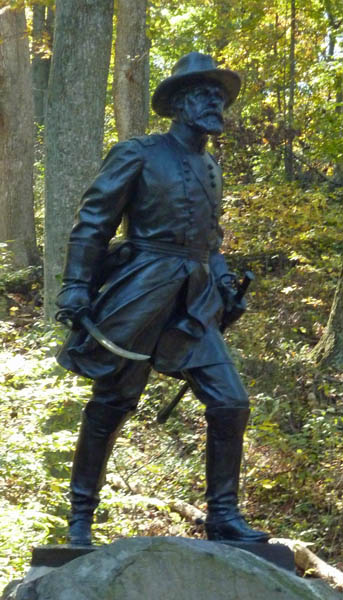
|
|
|
Judson Kilpatrick
"Kilpatrick is a hell of a damned fool"-W. T. Sherman *
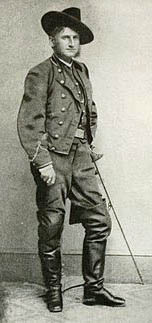
|
|
|
Dedication of John Sedgwick's Statue 1913
|
| 
|
|
In a calmer state of mind you re-cross Confederate Avenue and also Emmitsburg Road not far from the intersection. At this point you are walking downhill with Big Round Top rising in the distance in front of you. Once again the trail divides. If you continue straight ahead you continue along an improved short-cut from which you can see the south side of Devil’s Den. This short cut is not yet illustrated on the official map. Alternatively, you can turn right into the lane leading to the Bushman Farm house. When you go past the farm house you come to a narrow trail that runs between two stone walls. This was once the path of a miniature train that conducted tours of the battlefield. This is also a place where the amateur herpetologists among you might just observe a few harmless snakes catching the rays in warm weather. Those who would rather not might consider turning around and the using that other trail. When you come to the end you ride along the shoulder of the road for a distance. The vehicular traffic moves at a crawl here, and it is not too bad but unlike most of the ride you are close to traffic at this point. This area was the site of a tragic incident during the battle. After Pickett's charge failed, Judson Kilpatrick, a cavalry commander, ordered a cavalry charge against the opposing Confederate infantry, thinking that he could turn the Confederate right flank. His subordinate, Brigadier General Elon John Farnsworth attempted to dissuade him from his reckless order but when Kilpatrick implied cowardice on his part, Farnsworth led the doomed attack and died as a result. You will see a monument to Farnsworth along the road.
The two divisions of the trail join up here and currently the Park Service has closed the trail that once took you around the back of the round tops. I have elected to leave in this discussion the paragraphs below in the event the Park Service reopens the closed portions of the trail. As it stands now you must go up the other way and loop around and retrace your steps going the other direction back to your starting point at either Artillery Ridge or the McMillan Woods. This makes for a rather long ride but I understand the concept of historic preservation and the need of the Park Service to close this trail, which was always problematic in wet weather.
Sign at the End of the Line

|
|
|
"Can't I go on?"
The point at which the trail is closed.
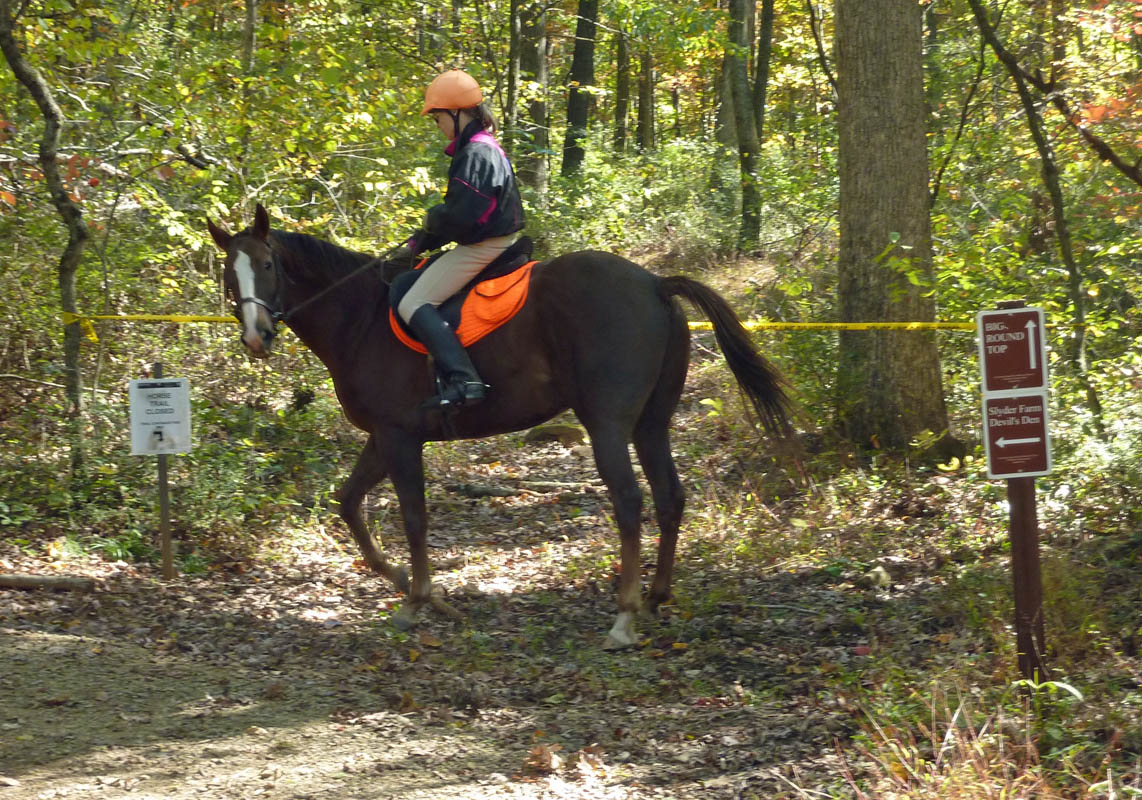
| |
Previously, it was possible to follow the trail here when it leaves the road and continues through a narrow, fairly rocky stretch through the woods on the south and east face of Big Round Top. Big Round Top was forested during the battle and since Civil War infantry and artillerymen needed to see what they were shooting at the hill did not have very much strategic value. The Federal line ended with the 20th Maine Infantry Regiment and your ride passes through the spot between Big and Little Round Top where they so bravely fought off the Confederate attack, and continues along the east face of Little Round Top. This stretch of trail is of necessity very narrow and rocky. Park policy is to alter the terrain as little as possible while at the same time allowing public access. Before you know it, you are crossing Wheatfield Road and are in the open again. You go past the equestrian statue of Union Major General John Sedgwick. There are many equestrian statues at Gettysburg, but Sedgwick’s is one that you can get a good look at from horseback. John Sedgwick is best remembered for his 1864 famous last words when speaking of Confederate sharpshooters, "They couldn't hit an elephant at this distance." You may have heard that there is significance to the number of feet that the horse has lifted off the ground in statues. However, I will not repeat what they say because although it happens to be true of the statues at Gettysburg, this was purely accidental and is not the result of any well-recognized conventions among sculptors. It was here that we happened to encounter a tourist group on those two-wheeled Segway Personal Transporters. Their guide was extremely courteous and asked if they might spook our horses, but they seemed fine with them.
The trail continues into an area that tends to be swampy in wet weather and even has stretches of boardwalk built in the trail. Horses that have no experience often bulk at walking on these, but ours prefer it to the mud. I remember the first time that one of my wife's one horses walked on these she walked in the manner of a duck. She had her legs spread wide and seemed to waddle. I do not think that I have ever seen a horse walk in such a funny way. At last you intersect with the short trail leading back to the Artillery Ridge Camping Resort and our starting point.
Forgive my poor attempts at levity, but I also want you to realize that you have just crossed hallowed ground. Men North and South gave their lives here in a struggle and not for their miserly 13 dollars a month salary but out of a sense of duty as citizens and their wish to defend the quite different principles that they held dear. Could you or I have done the same? You need to ask yourself that question and then this becomes something more than just a pretty ride. It is right and proper that the horse under you is here because his forbearers gave their last measure of devotion in this place as well. As a people we must not forget the lessons of our Civil War. As Americans we may have different political viewpoints, but we should never again raise our fists against our brothers but rather strive always to find the common ground.
Civil War Bullets from Private Land in Virginia
Remember disturbing any artifacts in National Parks is prohibited, severely punished and strictly enforced.

|
|
Tourists at Devil's Den
Generations of Americans have enjoyed Gettysburg. Protect and respect the park so that it will be there for future generations.
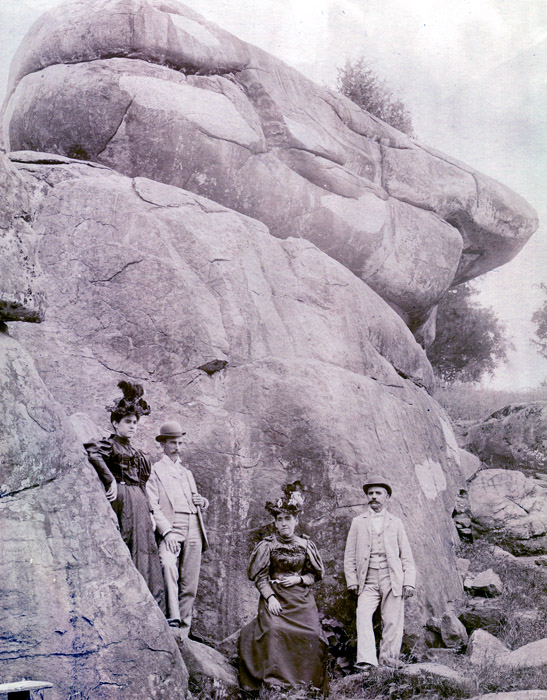
| |
I am as always just,
The Accidental Horseman.
* In all fairness to Kilpatrick this quote is taken out of context but as such it pretty much sums up the views of many historians.
The above is solely the opinion of the author and does not reflect the views of the National Park Service, The Gettysburg Equestrian Historical Society or the Artillery Ridge Campground.
MORE: Gettysburg National Military Park. Gettysburg, PA
Hickory Hollow Farm's Horseback Tours
History of U.S. Army Cavalry
The Use of Cavalry and Artillery during the American Civil War
Back to Additional Discussions
Links to Other Sites regarding Horses
Back to Index Page



